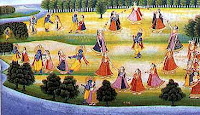Carnatic Music !!!!!!!!!!
 Carnatic music, also known as karnātaka sangītam is one of the two styles of Indian classical music, the other being Hindustani music. The present form of Carnatic music is based on historical developments that can be traced to the 15th - 16th centuries CE and thereafter. From the ancient Sanskrit works available, and the several epigraphical inscriptional evidences, the history of classical musical traditions can be traced back to about 2500 years.Carnatic music is completely melodic, with improvised variations. The main emphasis is on vocal music; most compositions are written to be sung, and even when played on instruments, they are meant to be performed in a singing style (known as gāyaki). Like Hindustani music, Carnatic music rests on two main elements: rāga, the modes or melodic formulæ, and tāka, the rhythmic cycles.
Carnatic music, also known as karnātaka sangītam is one of the two styles of Indian classical music, the other being Hindustani music. The present form of Carnatic music is based on historical developments that can be traced to the 15th - 16th centuries CE and thereafter. From the ancient Sanskrit works available, and the several epigraphical inscriptional evidences, the history of classical musical traditions can be traced back to about 2500 years.Carnatic music is completely melodic, with improvised variations. The main emphasis is on vocal music; most compositions are written to be sung, and even when played on instruments, they are meant to be performed in a singing style (known as gāyaki). Like Hindustani music, Carnatic music rests on two main elements: rāga, the modes or melodic formulæ, and tāka, the rhythmic cycles. Origins & History !!!!!!!!!!
The Sama Veda is said to have laid the foundation for Indian music, and consists main
 ily of hymns of Rigveda, set to musical tunes, and would be sung using three to seven musical notes during Vedic sacrifices, sometimes accompanied by an instrument.The Yajur-Veda, which mainly consists of sacrificial formulae, mentions the veena as an accompaniment to vocal recitations during the sacrifices.
ily of hymns of Rigveda, set to musical tunes, and would be sung using three to seven musical notes during Vedic sacrifices, sometimes accompanied by an instrument.The Yajur-Veda, which mainly consists of sacrificial formulae, mentions the veena as an accompaniment to vocal recitations during the sacrifices.Like all art forms in Indian culture, Carnatic Music is believed to have a divine origin, and music is venerated as an aspect of the supreme (nāda brāhmam).Ancient treatises describe the connection of the origin of swaras to the sounds of nature (as in animals and birds, the sound emanating from a bamboo reed as air passes through its hollows etc), and man’s keen sense of observation and perception that tried stimulating these sounds. Many scholars consider that folk music influenced the structure of Carnatic music too.
References to Indian classical music are made in many ancient religious texts, including epics like the Ramayana and Mahabharata. The Yajnavalkya Smriti mentions "Veena vadhana tathvangna sruti, jathi, visartha talanjaaprayasena moksha margam niyachathi" ("The one who is well versed in veena, one who has the knowledge of srutis and one who is adept in tala, attains salvation without doubt.")The historical roots of this tradition can be found in Bharata's Natya Shastra.Carnatic music is based on music concepts mentioned in Natya Sastra.Natya Shastra mentions many musical concepts (including swara and tala)that continue to be relevant to Carnatic music today. According to some scholars,Carnatic music shares certain classical music concepts with ancient Tamil music. The concept of Pann is related to Ragas used in Carnatic music.The rhythmic meters found in several musical forms (such as the Tiruppugazh) and other ancient literature, resemble the talas that are in use today.
Both Carnatic an
 d Hindustani music shared a common history. Since the late 12th and early 13th centuries, as a result of the increasing Persian influence (and as a result of the Islamic conquest) in North India, Hindustani Music started evolving as a separate genre, while Carnatic music was relatively unaffected by these Arabic and Iranian influences.In Carnatic Music (which was based in South India), the pan-Indian bhakti movement laid a substantial basis as far as the use of religious themes are concerned, while major developments post 13th century also contributed to its divergence from Hindustani music.
d Hindustani music shared a common history. Since the late 12th and early 13th centuries, as a result of the increasing Persian influence (and as a result of the Islamic conquest) in North India, Hindustani Music started evolving as a separate genre, while Carnatic music was relatively unaffected by these Arabic and Iranian influences.In Carnatic Music (which was based in South India), the pan-Indian bhakti movement laid a substantial basis as far as the use of religious themes are concerned, while major developments post 13th century also contributed to its divergence from Hindustani music. Carnatic music saw renewed growth during Vijayanagar Empire by the Kannada Hari
 dasa movement of Vyasaraja, Purandara Dasa, Kanakadasa and others.Purandara Dasa who is known as the Sangeeta Pitamaha (the grandfather of Carnatic music) laid out the fundamental tenets and framework for teaching carnatic music.Venkatamakhin is credited with the classification of ragas in the Melakarta System and wrote his most important work; Chaturdandi Prakasika (c.1635 CE) in Sanskrit. Govindacharya expanded the Melakarta Scheme into the Sampoorna raga system, which is the system in common use today.
dasa movement of Vyasaraja, Purandara Dasa, Kanakadasa and others.Purandara Dasa who is known as the Sangeeta Pitamaha (the grandfather of Carnatic music) laid out the fundamental tenets and framework for teaching carnatic music.Venkatamakhin is credited with the classification of ragas in the Melakarta System and wrote his most important work; Chaturdandi Prakasika (c.1635 CE) in Sanskrit. Govindacharya expanded the Melakarta Scheme into the Sampoorna raga system, which is the system in common use today.Even though the earlier writers Matanga, Sarangadeva and others also were from Karnataka, the music tradition was formally named Karnataka Sangeetham for the first time only in the 13th Century when Vijayanagara empire was found.
An excerpt from an external site... but yet interesting !!!!!!! :)
Cheers,
Pavi !! :)



